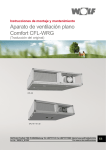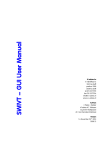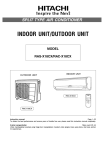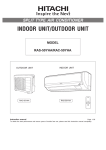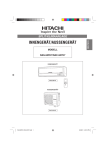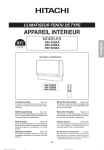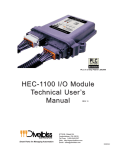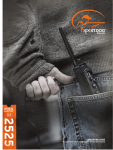Download SK Centrifugal Fan Operators Manual
Transcript
CFN-03-2 ffi Cor poration / Far m Fans Silver King Series Centrifugal Fan Low and High Speed Operators Manual CONTENTS Safety Precautions . . . . . . . .2 Warranty . . . . . . . . . . . . . . .2 Installation . . . . . . . . . . . . . .3 Dimensions (CFL) . . . . . . . .4 Dimensions (CFH) . . . . . . . .6 Operation . . . . . . . . . . . . . .8 Service . . . . . . . . . . . . . . . .9 Wiring Diagrams . . . . . . . .10 Safety Decals . . . . . . . . . .12 Models: CFL22 CFL24 CFL27 CFL30 CFL33 Models: CFH15 CFH18 CFH22 C C Copyright © 1999, 1998 ffi Corporation SAFETY PRECAUTIONS 1. Read and understand the operation manual before attempting to operate the unit. USE CAUTION IN THE OPERATION OF THIS EQUIPMENT 2. Keep ALL guards, access doors, covers, safety decals and safety devices in place and securely fastened. NEVER operate system while guards are removed. The design and manufacture of this system is directed toward operator safety. However, the very nature of any system using high voltage electrical equipment and rotation parts presents hazards to personnel which cannot be completely safeguarded against without interfering with efficient operation and reasonable access to components. 3. Keep all untrained personnel away from system components and control panel at all times. 4. NEVER attempt to operate the unit by jumping or otherwise bypassing any safety devices. Use extreme caution when working around rotating parts which may start without warning when the system is operating on "Automatic" control. 5. Always open the main power supply disconnect switch and lock it in the open position with a padlock when performing any service or maintenance work on the fan or control panel. Continued safe dependable operation of equipment relies, to a great degree, upon the operator. For a safe and dependable system, follow the recommendations within this manual, make it a practice to regularly inspect the operation of the system for any unsafe conditions or developing problems. 6. Lock out power before removing guards, access doors, and covers. 7. Keep hands, feet and clothing away from all rotating parts. TAKE SPECIAL NOTE OF THE OPERATING PRECAUTIONS BELOW BEFORE ATTEMPTING TO OPERATE THE SYSTEM. 8. Electrical repairs should be performed by trained qualified personnel only. Failure to follow safe electrical procedures can result in serious injury. CAUTION: Guards, access doors and covers must be securely fastened before operating this equipment. 9. If it should become necessary to perform checks on system components or high voltage tests with "live" circuits, be extremely careful and follow all established safety practices. A CAREFUL OPERATOR IS THE BEST INSURANCE AGAINST AN ACCIDENT. Look for this symbol to point out important safety precautions. It means ATTENTION! WARRANTY Farm Fans warrants its products to be free of defects in material and workmanship. The only obligation of the manufacturer is to repair or replace products which have been submitted and found to be defective within 24 months after installation. If so found defective, the products will be repaired or replaced without charge, this constituting and entirely fulfilling the warranty obligation. Farm Fans assumes no liability for expenses incurred without written authorization; in no event shall its liability include special or consequential damages or exceed the selling price of the product. dent. Some components supplied by manufacturers are warranted separately by those suppliers. This warranty is exclusive and in lieu of all other warranties, expressed or implied. Farm Fans reserves the right to make design or specification changes at any time without any contingent obligation to purchasers of products already sold. All instructions, with the exception of those concerning safety, shall be construed as recommendations only; because of the many variable conditions in actual installation, Farm Fans assumes no liability for results arising from the use of such recommendations. This warranty does not cover products or parts which have been damaged by negligent use, misuse, alteration or acci- Copyright © 1999, 1998 by ffi Corporation. All rights reserved. No part of this publication may be used or reproduced in any form or by any means without prior permission. Failure to comply with this notice is a violation of United States copyright laws. 2 INSTALLATION FOUNDATION forming any service on the unit. NOTE: The fused disconnect is provided by the owner and MUST BE CORRECTLY SIZED AND CONNECTED TO ALLOW PROPER MOTOR OPERATION. For proper operation of your ffi fan, the unit is to be mounted on a level pad. The fan should not be anchored to the pad but should be allowed to “float” on the pad. The fan pad should be at the same elevation as the floor of the bin or building. 1. See dimension illustration for the physical size of the fan. Use the dimensions shown to determine the position of the fan when installed. UNITS WITHOUT CONTROLS - It is the customer's responsibility to provide a fused disconnect and motor overload protection. The disconnect and overload device must be sized and connected correctly to allow proper motor operation. Failure to provide these components could cause severe motor damage and void the manufactures warranty. 2. Rotate the fan wheel to be sure it revolves freely and does not contact the housing. 4. Be sure that the disconnect and the fan are well grounded. 3. Check all fasteners on the fan to make sure they are tight (fasteners may loosen during shipping). If any loose fasteners are found, check for proper clearance and retighten. 5. The following wires must be supplied to each fan. Units without control transformers require a separate neutral and earth ground connection. FAN INSTALLATION 1PH 230V . . . . . . . . . . 3PH 230V . . . . . . . . . . 3PH 230V with optional transformer kit . . . . 3PH 460V/575V . . . . . 4. Check all electrical connections that may have loosened during shipping. 5. Make certain that all joints and seams around the lower part of the bin are well sealed to prevent air leakage from the air space under the perforated drying floor. The connecting air duct must be reasonably airtight. Air leakage wastes fan efficiency. . . . . . .L1, L2, N, G . . . . . .L1, L2, L3, N, G . . . . . .L1, L2, L3, G . . . . . .L1, L2, L3, G 6. Use electrical conductors of adequate size. Undersized wire can lead to voltage drop and cause motor overheating and shortened life. Therefore, it is necessary to know the distance from the unit to available transformer and the horsepower of your fan unit. These two factors will determine the size of wire needed for efficient operation. The full load current is listed in Tables 2 and 3 (1750 RPM) or Tables 5 and 6 (3500 RPM). The full load current is also stamped on the motor nameplate. 6. The connecting air duct or “transition duct” and connector should be all metal construction, with a gradual angle to the rectangular opening through the bin wall. 7. Avoid abrupt angles or any type of connecting air duct that would restrict airflow. The cross-sectional area of the connecting duct should gradually increase to about 1.5 times the fan area where it enters the air chamber through the bin wall. 7. The starter controls require 115VAC power to operate. On 230V 3PH units, this power is supplied by L1 to neutral. 8. Keep the air entrance as clear as possible from obstruction by floor supports. WARNING! The voltage between L1 and N must be 115VAC. Any other voltage may cause severe damage to equipment. 9. Adequate exhaust air openings in the roof are required to prevent any additional back pressure (2 to 3 times fan outlet cross-sectional area). Check this voltage before starting unit. If voltage is not within 105-125VAC, check for proper voltage on L2 or L3 and move to appropriate leg. If voltage is not acceptable, install a 0.25 KVA step-down transformer kit (part no. TRANS-230). (Note: Grounded B and some open delta power supplies will require this transformer kit.) ELECTRICAL INSTALLATION 1. The electrical installation must be performed by a certified electrician, in accordance with the appropriate national and local electrical codes. Any violation of electrical wiring codes could jeopardize the ffi warranty. INSTALLATION CHECK 2. ffi Corporation recommends contacting your local power company to advise them of the additional load to be placed on their line. Only the power company representative can ensure that their system is sized properly to provide adequate service to your facility and new equipment. When the fan is completely installed, the unit will need to be checked for proper rotation. Provide power to the fan controls and start the fan momentarily. Make sure that the fan wheel rotation is in the direction that the decal on the fan housing illustrates. If the decal is missing, note that the wheel should operate counterclockwise when viewed through the inlet guard. If the wheel is rotating the wrong direction, have your electrician correct the wiring. 3. Each fan motor must be supplied with an independent power circuit, equipped with a fused disconnect switch. Locate this switch near the unit, as the power should be shut off before opening the control box cover, or per- 3 C E N T R I F U G A L FA N D I M E N S I O N S ( L O W S P E E D ) 4C0338.DWG FAN MODEL CFL22-5 CFL24-7 CFL27-10 CFL27-15 CFL27-20 CFL30-25 CFL30-30 CFL33-40 CFL33-50 L1 L2 H1 37.88 41.88 45.75 45.75 45.75 50.50 50.50 55.75 55.75 15.31 17.04 18.38 18.38 18.38 20.00 20.00 22.25 22.25 44.00 48.25 53.00 53.00 53.00 58.88 58.88 64.75 64.75 CFL FAN DIMENSIONS W1 H2 H3 1-PH 3-PH 25.09 24.50 31.50 30.25 27.50 27.25 33.50 33.50 30.12 29.75 35.00 33.50 30.12 29.75 40.00 38.00 30.12 29.75 40.00 33.36 33.25 46.50 33.36 33.25 46.50 36.64 36.60 50.50 36.64 36.60 52.50 W2 W3 W4 D1 18.12 19.00 19.00 21.88 23.12 24.50 24.50 26.31 28.25 15.12 16.00 16.00 18.88 20.12 21.50 21.50 23.31 25.25 1.5 1.5 1.5 1.5 1.5 1.5 1.5 1.5 1.5 7.06 8.00 7.20 10.12 11.39 11.25 11.78 12.25 14.11 K:\EXCEL\4C-0338.XLS TABLE 1 1750 RPM CENTRIFUGAL FAN STATIC PRESSURE (INCHES) & AIR FLOW RATINGS (CFM) FAN MODEL CFL22-5 CFL24-7 CFL27-10 CFL27-15 CFL27-20 CFL30-25 CFL30-30 CFL33-40 CFL33-50 0.00 1.00 2.00 AIRFLOW IN CFM 7870 7600 6970 10320 10180 9520 12580 12260 11690 17750 17410 16590 20050 19670 18750 24660 24090 23180 25880 25290 24340 29320 28420 27500 34020 32970 31900 3.00 6320 8870 11040 15770 17820 22260 23370 26680 30950 PRESSURE IN INCHES 4.00 5.00 6.00 5540 8150 10400 14900 16840 21340 22410 25600 29700 4290 7250 9720 13920 15730 20370 21390 24520 28440 5620 8870 12710 14360 19300 20260 23380 27120 7.00 8.00 9.00 10.00 11.00 7630 10910 12330 18050 18950 22220 25780 16430 17250 20940 24290 19580 22710 18270 21190 17100 19840 Airflow ratings w ere determined in accordance w ith AMCA test code Standard 210. cflcfm.xls 4 TA B L E 2 C F L E L E C T R I C A L S E R V I C E - S I N G L E P H A S E MOTOR HP 5 7.5 10 15 Full Load Amps 22.8 32 40 66.7 230V Single Phase Overload Relay / Heater Element / Part Number Part Number 27A / 056-1062-1 C25.0B / 056-1163-3 45A / 056-1046-4 C30.3B / 056-1142-1 45A / 056-1046-4 C36.6B / 056-1200-7 90A / 056-1083-7 F77.2B / 756-1677-1 TABLE 3 CFL ELECTRICAL SERVICE - THREE PHASE 230V Three Phase MOTOR HP 5 7.5 10 15 20 25 30 40 50 Full Load Amps 13.2 20 26 38 52 64 76 100 124 Overload Relay/ Part Number 12-18A / 056-1944-0 23-32A / 056-2079-4 30-40A / 056-2066-1 37-50A / 056-2000-0 48-65A / 056-1995-2 55-70A / 056-2118-8 63-80A / 056-2143-8 90-150A / 056-2276-6 90-150A / 056-2276-6 Overload Setting 13.4 23 30 40 55 64 76 100 124 460V Three Phase MOTOR HP 5 7.5 10 15 20 25 30 40 50 Full Load Amps 6.6 10 13 19 26 32 38 50 62 Overload Relay/ Part Number 7-10A / 056-2022-4 9-13A / 056-1971-3 12-18A / 056-1944-0 17-25A / 056-1943-2 23-32A / 056-2079-4 30-40A / 056-2066-1 37-50A / 056-2000-0 48-65A / 056-1995-2 63-80A / 056-2143-8 Overload Setting 7 10 13 19 27 32 38 50 63 575V Three Phase MOTOR HP 5 7.5 10 15 20 25 30 40 50 Full Load Amps 5.3 8 10.4 15 20.6 25.5 30 38 48 Overload Relay/ Part Number 5.5-8A / 056-1996-0 7-10A / 056-2022-4 9-13A / 056-1971-3 12-18A / 056-1944-0 17-25A / 056-1943-2 23-32A / 056-2079-4 23-32A / 056-2079-4 37-50A / 056-2000-0 48-65A / 056-1995-2 Overload Setting 5.5 8.6 11.5 15.5 21 26 30.5 38 48 CFLELECSERVICE.xls 5 C E N T R I F U G A L FA N D I M E N S I O N S ( H I G H S P E E D ) TA B L E 4 3 5 0 0 R P M C E N T R I F U G A L FA N S TAT I C P R E S S U R E ( I N C H E S ) & A I R F L O W R AT I N G S ( C F M ) PRESSURE FAN MODEL CFH15-5 CFH18-7 CFH18-10 CFH18-15 CFH22-20 CFH22-25 CFH22-30 CFH22-40 CFH22-50 1" 2" 3" 4" 5" 6" 7" 8” 9” 10” AIRFLOW 3770 4220 5810 8100 7960 9660 11400 14720 18610 3620 4150 5830 7870 7670 9420 10900 14500 18100 3430 4100 5690 7590 7630 9180 10720 14310 17710 3200 3950 5510 7400 7440 8940 10550 14050 17500 2920 3850 5320 7170 7160 8690 10240 13750 17010 2610 3740 5170 6920 6890 8440 10000 13510 16820 2250 3650 4980 6630 6590 8180 9900 13300 16510 1860 3530 4810 6230 6330 7920 9800 13000 16200 IN 1420 3390 4650 5930 6250 7780 9550 12690 15820 IN -3240 4430 5750 6120 7650 9300 12450 15510 INCHES 11” 12” 13" 14" 15" 16" 17" 18" 19" 20" -2940 4010 5150 5980 7400 8910 11880 14890 -2750 3570 4890 5820 7250 8690 11550 14530 -2450 3360 4370 5730 6970 8490 11280 14090 ---3980 5620 6720 8210 10970 13890 ---3560 5340 6410 8010 10610 13200 ----5210 6200 7770 10010 12600 ----5010 6000 7410 9820 11980 ----4760 5650 7090 9320 11390 ----4490 5310 6680 8880 11000 CFM -3070 4250 5520 5890 7500 9210 12110 15020 Airflow ratings were determined in accordance with AMCA test code Standard 210. 6 TA B L E 5 C F H E L E C T R I C A L S E R V I C E - S I N G L E P H A S E MOTOR HP 5 7.5 10 Full Load Amps 19.5 33 40 230V Single Phase Overload Relay / Heater Element / Part Number Part Number 27A / 056-1062-1 C21.4B / 056-1368-0 45A / 056-1046-4 C33.0B / 056-1153-8 45A / 056-1046-4 C36.6B / 056-1200-7 TABLE 6 CFH ELECTRICAL SERVICE - THREE PHASE 230V Three Phase MOTOR HP 5 7.5 10 15 20 25 30 40 50 Full Load Amps 12 18.8 24 34.2 46 60 72 92 116 Overload Relay/ Part Number 12-18A / 056-1944-0 17-25A / 056-1943-2 23-32A / 056-2113-1 30-40A / 056-2066-1 37-50A / 056-2000-0 55-70A / 056-2118-8 63-80A / 056-2143-8 90-150A / 056-2276-6 90-150A / 056-2276-6 Overload Setting 12 19 24 35 46 60 72 92 116 460V Three Phase MOTOR HP 5 7.5 10 15 20 25 30 40 50 Full Load Amps 6 9.4 12 17.1 23 30 36 46 58 Overload Relay/ Part Number 5.5-8A / 056-1996-0 9-13A / 056-1971-3 12-18A / 056-1944-0 17-25A / 056-1943-2 23-32A / 056-2079-4 30-40A / 056-2066-1 37-50A / 056-2000-0 48-65A / 056-1995-2 55-70A / 056-2118-8 Overload Setting 6 10 12 18 23 32 37 48 58 575V Three Phase MOTOR HP 5 7.5 10 15 20 25 30 40 50 Full Load Amps 4.8 7.2 9.6 13.7 18.5 22.5 29 37.5 45.5 Overload Relay/ Part Number 4-6A / 056-1968-9 7-10A / 056-2022-4 9-13A / 056-1971-3 12-18A / 056-1944-0 17-25A / 056-1943-2 17-25A / 056-1943-2 23-32A / 056-2079-4 37-50A / 056-2000-0 37-50A / 056-2000-0 Overload Setting 5 7.5 10 14 18.5 22.5 29 37.5 45.5 CFHELECSERVICE.xls 7 O P E R AT I O N After initial installation and also prior to using the unit each season, check the operation to ensure proper functioning, adjustment, and reliability. 5. Press the fan START button and check the following: A. Check direction of wheel rotation. THIS IS A VERY IMPORTANT CHECK ON INITIAL START-UP OF 3PHASE MODELS. The wheel must rotate counterclockwise when viewed through the inlet guard. FAN OPERATION 1. Make certain that unit is properly installed and connected, as described within the installation instructions. All air passage joints and seams must be well-sealed. NOTE: 3-Phase motors may be reversed by interchanging any two power leads. B. Check to make sure the wheel comes to full operating speed in less than 10 seconds. If there is any doubt as to proper operation, check the current draw of the motor. The motor amperage should not exceed the maximum full load amps listed within Tables 2 and 3 (1750 RPM) or Tables 5 and 6 (3500 RPM). 2. With main power supply turned OFF, rotate the wheel by hand to make certain it turns freely without contacting the housing or inlet cone. 3. Open roof doors to allow airflow at all times when fan is operating. CAUTION: Fan pressures can overload bin roof or walls causing structural damage or collapse. Bin must be adequately ventilated and fans and screens free of obstructions. Do not run fans if icing can occur on screens. FAN SHUT-DOWN 1. Press the fan STOP button on units equipped with motor controls. 2. Shut off electrical power at main and at disconnect. 4. Turn ON main power disconnect switch. 3. Close the roof openings and cover fan inlet to prevent harmful back-draft air currents from passing through the grain and to avoid grain infestation from rodents and insects. CAUTION: Make certain all guards and covers are securely in place. SERVICE REMOVAL FAN WHEEL REMOVAL & INSTALLATION 1. LOCK-OUT THE MAIN POWER SUPPLY and remove the fan guard and inlet cone. The fan wheel is secured to the motor shaft by the use of a taper-lock bushing, motor shaft key, and capscrews. The size, quantity, and torque of capscrews required will depend on the model of the fan. 2. Remove the three capscrews from the clearance holes in taper-lock bushing. Inspect for thread damage and set aside for later reinstallation (do not use these bolts for step 3, bushing removal). CAUTION: Although the taper-lock method of retaining the wheel onto the motor shaft is very simple and obvious, it is essential that the following points be read carefully and fully understood, as improper installation can result in serious or fatal injury caused by a loose, fast flying wheel. 3. Install two Grade 5 (or better) capscrews into the THREADED HOLES in the bushing and turn them in by hand until they bottom against the front surface of the wheel. These capscrews should not be used for reassembly, as some thread distortion could occur during the removal operation. Grade 5 screws are marked with three 120° spokes on the head and are more durable than low strength unmarked bolts. THREADED BUSHING HOLES: The threaded holes within the bushing are provided for disassembly purposes only. Do not attempt to use these holes for reassembly, as they will not allow the parts to become locked onto the shaft, thereby causing an extremely hazardous operating condition. NOTE: DO NOT ATTEMPT TO USE LOW STRENGTH (UNMARKED) BOLTS TO REMOVE THE BUSHING, AS THE BOLTS MAY BREAK OFF. CLEARANCE HOLES: When reassembling parts, the capscrews must be installed through the UNTAPPED CLEARANCE HOLES to cause the wheel to be pulled forward onto the tapered bushing, thus locking the parts securely onto the motor shaft. Refer to text for assembly details. 4. Block wheel to prevent it from turning, and GRADUALLY TURN IN THE CAPSCREWS (up to 1/4 turn at time), until the wheel breaks loose from the bushing and motor shaft. Carefully remove bushing and wheel. With the wheel free from the bushing, a wheel puller can be used to pull the bushing off of motor shaft, if 8 required. Reattach bushing onto wheel to prevent the loss of parts and also to maintain the original alignment of bushing to wheel. Inspect wheel and bushing at this time, looking for any cracks, thread or bolt damage, warpage, etc. Consult your dealer or the factory for any questions concerning damage. Refer to the following chart for recommended capscrew tightening torques. DO NOT EXCESSIVELY OVERTIGHTEN THE BUSHING. CAUTION: Do not attempt to pull the flange of the bushing flush with the wheel hub. A clearance of from 1/8" to 1/4" must be maintained between bushing flange and wheel hub surface. INSTALLATION 8. Turn wheel by hand and check it for freedom of rotation and uniform clearance around inlet cone before reinstalling the fan guard. 1. Carefully clean motor shaft, key, bushing and bore of wheel. MAKE SURE MAIN POWER IS LOCKED OUT, and that shaft and key are completely free of rust and burrs. Do NOT lubricate the bushing or capscrews. CHECK AND MAKE SURE ALL MOTOR MOUNT BOLTS ARE PROPERLY TIGHTENED. FAN MOTOR REMOVAL & INSTALLATION In the event of motor failure, remove the motor, as described, and take it to the nearest Authorized Service Station. AUTHORIZED SERVICE STATIONS ARE THE ONLY PLACES THAT CAN PROVIDE MOTOR WARRANTY. Motor service and repair at other places will be at owner’s expense. Before installing the wheel, check the following: (1) All foreign material should be removed from the wheel. (2) Carefully inspect the wheel weldment and hub casting for damage, cracks, or other defects. Contact the factory if there is any question regarding the structural integrity of the wheel. If service station determines motor failure to be caused by faulty material or workmanship, repair will be under warranty when within the warranty period. Motor failure because of external causes will result in a charge to the owner for repair. 2. Slide wheel over motor shaft and locate it against the motor. 3. Align the keyway in the bushing with the key and SLIDE bushing onto motor shaft. Do not attempt to drive the bushing onto the shaft, as it may damage the motor bearings. 1. Make certain power is shut off and locked out, then remove fan guard, inlet cone, and wheel as outlined earlier. 4. Rotate the bushing and wheel so their key slots are in line and loosely attach the wheel to the bushing. MAKE SURE THE CAPSCREWS ARE INSERTED INTO THE UNTHREADED CLEARANCE HOLES IN THE BUSHING. Refer to previous CAUTION note. Locate the bushing so it is approximately flush with the end of motor shaft. 2. Open motor junction box cover and disconnect the motor lead wires from within the box. NOTE: Tag, or otherwise identify wires for ease of reassembly. 3. Remove motor mount bolts. If there are any shims between the motor and its base, note their locations so they can be properly installed during reassembly. Make certain that the proper capscrews are used for reassembly and no damage has occurred to these screws during disassembly! Use only the special type bolts supplied with the original wheel. 4. Disconnect the motor end of the motor conduit, if required, then carefully pull conduit and wires through hole in the motor junction box. Remove motor. If motor requires service, take it to an Authorized Service Station. 5. Install inlet cone, checking clearance between fan wheel and inlet cone. Shift the location of inlet cone as required to center it in relation to the fan wheel, providing equal clearance completely around the fan wheel. Tighten inlet cone bolts. 5. To reinstall motor, slide onto motor base plate and replace shims (if required) between motor and base plate. Reinstall motor mount bolts and washers, and fully tighten them at this time. 6. Slide the wheel forward onto the taper-lock bushing and turn the capscrews in by hand as far as possible. Reinstall conduit and wires and carefully remake all electrical wiring connections. NOTE: The bushing must be located far enough forward so the distance from the inside of the backplate of the wheel weldment to the closest edge of the inlet cone is equal to the dimension shown as ‘D1’ in the Fan Dimension Chart. Add approximately 1/8” to this dimension to allow the wheel to be pulled toward the inlet during tightening. NOTE: Make sure to install and tighten the wheel in accordance with earlier instructions. Browning Taper-Lock Bushing Bolt Tightening Torques Bushing Size Hex Bolt Size Torque (Inch-Lbs.) P 5/16-18x1-1/4 192 Q 3/8-16x2 348 B 5/16-18x1-1/4 192 7. Use an INCH-POUNDS torque wrench and GRADUALLY TIGHTEN the three capscrews (1/4 turn at a time) until the taper bushing becomes fully seated. 9 WIRING DIAGRAMS Fig. 1 Fan control box wiring diagram - 230V 1-Phase, for all models including the CFL27-1512-WC w /motor spec# 39P002W747 (Manufactured after 3/1/2000) Fig. 2 Fan control box wiring diagram - 230V 1-Phase CFL27-1512-WC models w /motor spec# 39F76470 (Manufactured prior to 3/1/2000) 10 Fig. 3 Fan control box wiring diagram - 230V 3-Phase models Fig. 4 Fan control box wiring diagram - 460V / 575V 3-Phase models 11 SAFETY DECALS Safety decals should be read and understood by all people in the grain handling area. If a decal is damaged or missing, contact: ffi Corporation 5900 Elmwood Ave. Indianapolis, IN 46203 IMPORTANT THIS UNIT IS WIRED FOR 230 VOLT, 1-PHASE POWER SUPPLY (Typical for 230V 1 phase models) Copyright © 1999, 1998 ffi Corporation 5900 Elmwood Ave. Indianapolis, Indiana 46203 10-22-99 12












